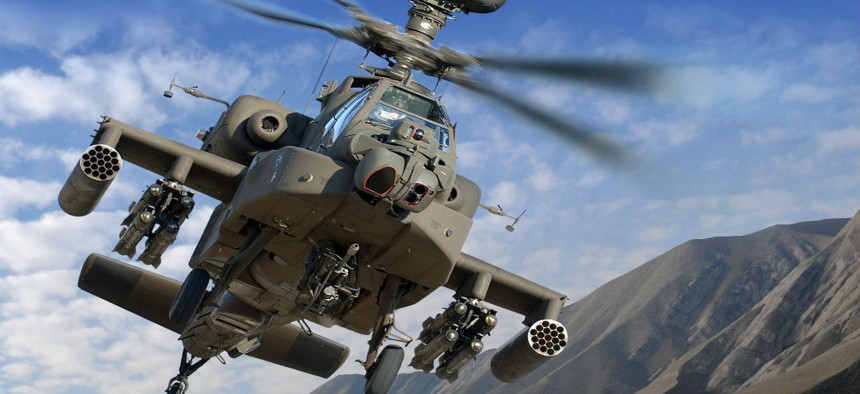New Army technology enables simultaneous multiple drone control
A new level of Army manned-unmanned teaming improves the ability of helicopter crews to track and identify enemy targets from the cockpit.
The Army has developed technology which enables drone air commanders to operate and view the real-time video feeds of multiple drones for helicopter crews simultaneously, improving existing service Manned-Unmanned Teaming (MUM-T), service officials said.
The emerging technology expands upon currently operational MUM-T that allows Apache and Kiowa helicopter crews to view real-time feeds from nearby drones while also controlling the sensor payload.
The new system, called Supervisory Controller for Optimal Role Allocation for Cueing of Human Operators (SCORCH), takes this technology a step further by giving in-flight helicopter crews an ability to view multiple drone feeds simultaneously.
"SCORCH is a system consisting of intelligent UAS autonomous behaviors and an advanced user interface that allows a single operator to effectively control up to three UAS simultaneously," said Dr. Grant Taylor, Aviation Development Directorate Engineering Research Psychologist.
Service innovators, working with the Army Aviation and Missile Research, Development and Engineering Center (AMRDEC), said that new interfaces are part of a long-term Army project aimed at advancing sensor-to-shooter time for helicopter attack missions.
The most recent operational MUM-T technology, called Level 4 LOI (Level of Interoperability 4), has been used with great success in Afghanistan by the 1-229th Attack Reconnaissance Battalion.
Level 4 LOI MUM-T enables AH-64E Apaches and OH-58 Kiowas to control the flight path and sensor payload of Army Shadow and Gray Eagle drones.
An Army official working on drone technological development told Defense Systems “MUM-T Operations are made possible by the introduction of a standardized interoperability protocol supporting video/data transmissions between ground-manned-unmanned platforms. This manned-unmanned network allows for the handoff of payload control, receiving and transmitting of real-time streaming video and manned pilots to control unmanned aircraft.”
A statement from the Association of the United State Army said that the MUM-T data link can retransmit drone or Apache sensor and targeting systems and full-motion sensor video and metadata to another MUM-T equipped Apache.
The technology can also transmit to ground forces equipped with the One Station Remote Video Terminal.
Peter Singer, Strategist at New America and author of “Wired for War,” sees substantial cost advantages of this technology as well.
“In the military today, humans are actually the greatest budget cost, so the present model of multiple people to one unmanned system has to be reversed if there are ever to be true cost savings. In turn, a swarm of drones can extend across greater geographic space than a single system,” he said.
MUM-T uses Tactical Common Data Link Assembly for the AH-64E, providing fully integrated LOI 3 and 4 with ranges exceeding 50 km.
The next phase of MUM-T, called Level 5 LOI, is aimed at allowing helicopter pilots to land drones from the cockpit while in flight. The technology, Army developers say, is still in an early developmental phase.
Army helicopter crews, who have used MUM-T in combat, say the combination of the Apache’s lethal weapons and the drone’s sensors allow helicopter crews to find and go after dynamic or fast-moving targets from farther ranges.
In addition, Apache helicopters are providing air support to Iraqi Security Forces advancing on Mosul.
For instance, looking at real-time Electro-Optical/Infrared images from drone cameras in the Apache cockpit gives crews an increased ability to destroy groups of enemy fighters on-the-move in pickup trucks or attack insurgents hiding near a known U.S. Army convoy route.
Army developers said that MUM-T has enabled Apache attack helicopter crews to bring up drone feeds, look through sensors and identify targets up to 60 miles away.
Maintaining drone sensors on targets, which can move and change, gives the Apache crew an opportunity to make adjustments while en route to a target location.
Apache pilots in Afghanistan are now flying upgraded AH-64 model helicopters which give the platform increased speed and performance.
In development for many years and now part of the operational force, the AH-64E models use a stronger 701D helicopter engine, composite rotor blades and next-generation communications technology and avionics.
The current D model Longbow Apache is heavier than the original A model helicopter; it carries the Longbow radar and significantly improved targeting and sensing technologies; however, it lacks the transmission-to-power ratio and hard-landing ability of the initial A model.
In total, the Army plans to acquire 690 AH-64Es by 2025. The AH-64E is highly mobile, lethal and can destroy armor, personnel and material targets in obscured battlefield conditions at ranges out to 8-kilometers, an Army statement said.





